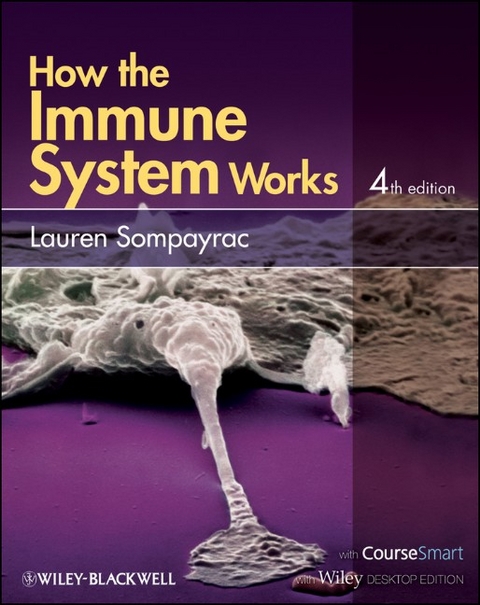
How the Immune System Works
Wiley-Blackwell (Verlag)
978-0-470-65729-4 (ISBN)
- Titel ist leider vergriffen;
keine Neuauflage - Artikel merken
How the Immune System Works is now accompanied by a FREE enhanced Wiley Desktop Edition - the interactive, digital version of the book - featuring downloadable text and images, highlighting and note taking facilities, book-marking, cross-referencing, in-text searching, and linking to references and glossary terms. It is also available from CourseSmart for instant, online and offline access for studying anytime, anywhere.
Professor Lauren Sompayrac is formerly of the University of Colorado at Boulder
Acknowledgments, vii How to Use This Book, viii This book is neither a comprehensive text nor an exam-review tool. It is an overview of the immune system designed to give anyone who is learning immunology a feel for how the system all fits together. The Anytime, Anywhere Textbook, ix LECTURE 1 An Overview, 1 The immune system is a "team effort," involving many different players who work together to provide a powerful defense against invaders. Focusing in on one player at a time makes it hard to understand the game. Here we view the action from the grandstands to get a wide-angle picture of what the immune system is all about. LECTURE 2 The Innate Immune System, 13 The innate immune system is a "hard-wired" defense that has evolved over millions of years to recognize pathogens that commonly infect humans. It provides a rapid and powerful defense against "everyday" invaders. LECTURE 3 B Cells and Antibodies, 24 B cells and the antibodies they produce are part of the adaptive immune system. This defense evolves during our own lifetime to protect us against invaders that we, personally, have never encountered before. LECTURE 4 The Magic of Antigen Presentation, 38 T cells, another weapon of the adaptive immune system, only recognize invaders which are "properly presented" by specialized antigen presenting cells. This feature keeps these important cells focused on the particular attackers which they are able to defend against. LECTURE 5 T Cell Activation, 52 Before they can spring into action, T cells must be activated. This requirement helps ensure that only useful weapons will be mobilized. LECTURE 6 T Cells at Work, 60 Once they have been activated, helper T cells orchestrate the immune response, and killer T cells destroy infected cells. LECTURE 7 Secondary Lymphoid Organs and Lymphocyte Trafficking, 70 B and T lymphocytes travel through secondary lymphoid organs looking for the invaders they can defend against. Once activated, B and T cells are dispatched to those areas of the body in which they can be most useful. LECTURE 8 Restraining the Immune System, 81 The powerful weapons of the immune system must be restrained lest they become "overexuberant." In addition, once an invader has been defeated, the immune system must be "reset" to prepare for future attacks. LECTURE 9 Tolerance Induction and MHC Restriction, 86 T cells must be trained to focus on appropriately presented invaders, and B and T lymphocytes must learn not to attack our own bodies. LECTURE 10 Immunological Memory, 96 B and T cells remember invaders we have previously encountered, and respond much more quickly and effectively to a subsequent attack by the same invader. LECTURE 11 Vaccines, 102 Vaccines are used to safely mimic the attack of an invader so that our immune system will be primed and ready for a real attack. LECTURE 12 The Immune System Gone Wrong, 107 The immune system generally does a good job of defending us while infl icting minimal "collateral damage." Sometimes, however, mistakes are made. LECTURE 13 Immunodeficiency, 116 Serious disease may result when our immune system does not operate at full strength. LECTURE 14 Cancer and the Immune System, 121 Because the immune system is set up to minimize the chance that its weapons will attack our own bodies, it is not very good at defending us against cells that have become cancerous. LECTURE 15 A Critique of the Immune System, 128 The immune system has many strengths - and a few weaknesses. Glossary, 133 Index, 136
| Zusatzinfo | Illustrations |
|---|---|
| Verlagsort | Hoboken |
| Sprache | englisch |
| Maße | 218 x 273 mm |
| Gewicht | 452 g |
| Themenwelt | Medizin / Pharmazie ► Medizinische Fachgebiete |
| Studium ► Querschnittsbereiche ► Infektiologie / Immunologie | |
| ISBN-10 | 0-470-65729-4 / 0470657294 |
| ISBN-13 | 978-0-470-65729-4 / 9780470657294 |
| Zustand | Neuware |
| Haben Sie eine Frage zum Produkt? |
aus dem Bereich



